Home > Skills and abilities >
Nowadays, children are accustomed to shoes with Velcro or without fasteners at all. And when they have to deal with tying their shoelaces, real panic begins - after all, no one has ever explained to the baby how to tie them correctly, and what is it anyway? In kindergarten, teachers recommend buying shoes without laces so that the child can serve himself. Outdoor shoes most often have Velcro, but at school, during physical education lessons or training, the baby will have to face the problem of tying shoelaces. And this is where parents will have a very difficult time.
What should parents who are faced with this problem do? How to teach a child to tie his shoelaces as quickly as possible? How to explain to a child the need for this process?
- 1 Training rules
- 2 Let's start classes
- 3 Games with laces
Training rules
To ensure that the learning process brings only joy to the child, parents should be patient. After all, he will not understand much of your explanations. So, if you are wondering: how to teach a child to tie his shoes, it’s simple. The following rules should be followed:
- the child must be of a suitable age. Four to five years is the optimal age.
- Girls develop faster than boys, and therefore if your child has a desire to learn, then you should not deny him this.
- The baby must firmly know which leg is left and which is right.
- Don’t teach your child several ways to tie his shoelaces – he’ll just get confused.
If all these rules are taken into account, then you can safely start teaching your baby.
At what age is it time to learn to tie shoelaces?
Educational psychologists answer this question in different ways. Let us turn to some written works on raising children. So, for example, in his educational program, or rather, in the strategies and tactics for raising children, the famous teacher M. Monterssori identifies several so-called zones of child development:
- zone of mental development;
- sensory zone;
- zone of practical life.
Let's pay attention to the latter. Maria Monterssori notes that this area is especially important for children. The practical life area includes skills and abilities such as the ability to take care of oneself, wash oneself, brush teeth, get dressed, and also use various things like a zipper on a jacket, buttons on a shirt, and laces on sneakers. The teacher identifies 2.5–3.5 years as the appropriate age for teaching such things. Other experts say the age ranges from 3 to 6 years. But they all agree that the first attempts to teach a child to tie his shoes should be made when he begins to understand what he is being taught, what is being done and why it is needed.
It is awareness of your own actions that will help you quickly learn this skill.
The age of awareness falls on average at 2–3 years, depending on the child’s development, surrounding factors, his psychological health, etc. This is exactly the time when a person’s very first memories of childhood are formed and memory begins to work more actively.
Thus, we can conclude that you need to start teaching your daughters and sons to tie their shoelaces when there is a practical need for it. For example, when the baby goes to kindergarten and he needs to put on his own shoes for a walk or sneakers for physical education.
In this case, the parents’ efforts will not be in vain. After all, the baby will begin to repeat the same movements every day under your control and in the end will forever remember how to wrap the proverbial bow.
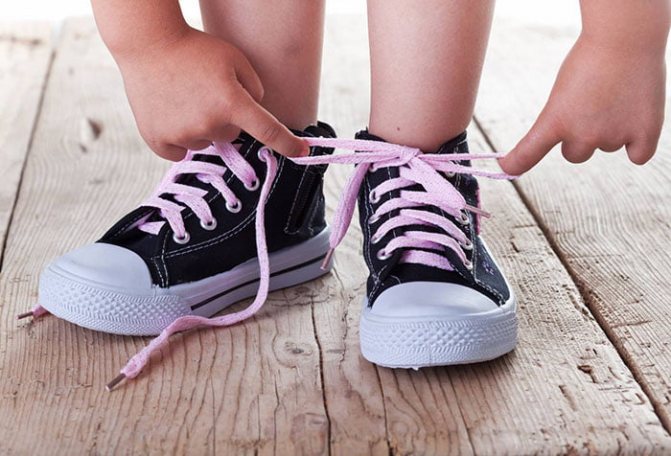
Let's start classes
First, you need to sit not opposite the child, but next to him. This should be done so that the child does not copy your movements in a mirror image, but simply repeats everything after you.
Then you need to choose the easiest way to tie. And start by teaching your child how to make knots, and only then start making bows.
Now you need to explain to the child that the loop is made only at one end of the lace, and the other end will be pulled into the loop, but not all the way. This is how a “bow” is formed.
There is a simple method for lacing boots - “grandmother’s way.” This is when loops are made on both halves of the lace at once and they are tied together. However, this method has its big disadvantage - the knots will quickly unravel. Try not to scold your child for failures.
Otherwise, the baby will never be able to overcome the fear of laces. After all, for him it will become associated with punishment and discontent of his parents. Be sure to praise the baby, because he is trying. And don’t try to teach him everything in one day. Spend at least five to ten minutes a day on the process and your baby will succeed. The main thing is to practice with it every day, so you will consolidate the results.
You can make learning fun with games and rhymes. For example, take the two ends of the lace and say: “There were two worms, Bim and Bom.” Tie the shoelaces together - They hugged each other and went for a walk - tie a knot and tighten it. - And how they are having fun! - wave your tails.
Can you tell your little one this rhyme:
- Darling bunny,
- It has two ears - make loops from laces.
- The bunny walked around the bush - twist one loop about the other.
- When you go into your hole, insert the loop into the hole.
- That's all! – tighten the lace.
How to teach a child to tie shoelaces step by step
To make the learning process easier for parents and more understandable for children, there is a bow-tying technique.
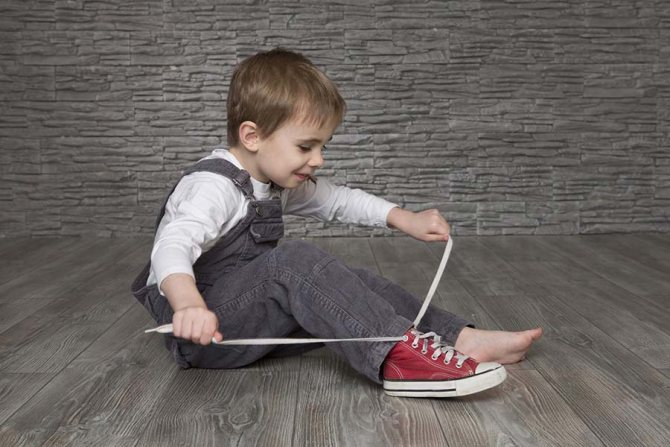
The main thing is step-by-step implementation
Tying technique
- Fold the two ends crosswise.
- Thread the end that is on top from bottom to top and tie a knot.
- Fold one end into a loop.
- Fold the second end into a loop while holding the first.
- Place a loop one on top of the other.
- The loop that is at the top is inserted from below and brought up.
- Tighten.
How to teach a child to count - effective and proven methods
Games with laces
The best way for a child to learn information is through play. That’s why it’s best to learn how to tie shoelaces while playing. Buy special lacing toys for your baby. They come not only in the form of shoes, but also in the form of interesting fruits and vegetables that you need to pass the caterpillar through. Agree, the child will definitely be interested.
Such toys perfectly develop fine motor skills.
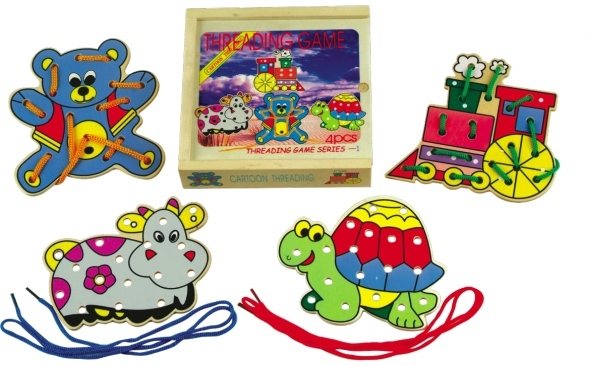
Parents should firmly understand a simple thing: learning to tie shoelaces is difficult not only for them, but also for the child. After all, he has to learn something that he has not encountered before. Therefore, you should be patient. Praise your child for every success and do not scold him for failures. After all, your support is so important to him. And remember, with the help of tenderness and affection it is much easier to teach a child something than with shouting and misunderstanding. Love your baby, and everything will work out easily and naturally, but the question: “How to teach a child to tie his shoelaces?” – you won’t have this problem again.
How to teach your child to tie his shoelaces quickly and easily
Despite the fact that modern children's shoes are often made with Velcro or straps, it is necessary for a child to be able to tie shoelaces. Firstly, at an older age he will probably have lace-up shoes, and secondly, if the baby starts playing sports, he will not be able to put on specialized sports shoes on his own. Additionally, this process helps teach discipline and independence.
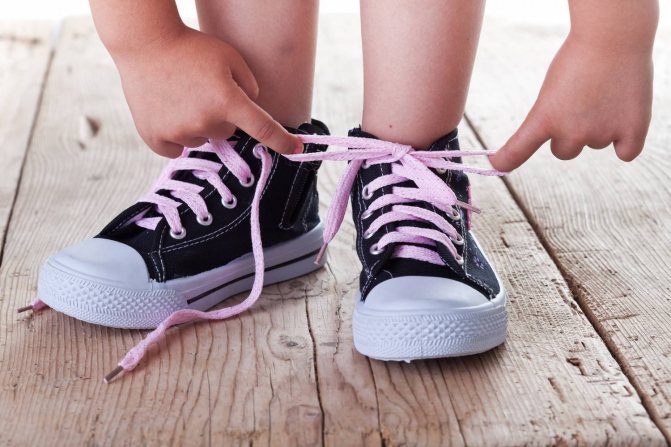
You need to know how to tie your shoelaces
Recommended age for learning to lace
If a child has developed fine motor skills, from the age of three he can easily master the skill of tying a bow.
Note ! Fine motor skills are how a child can make precise and small movements with his hands in a coordinated manner. It must be developed from birth.
To do this, there are a huge number of different exercises (stroking the baby’s palms and fingers, moving objects with different surfaces along the inside of the palm, rearranging beads, pebbles, etc.).
Also, to master this skill, it is necessary to teach children perseverance, otherwise they will not be able to absorb information and train for a long time.
Optimal age to start training according to teachers’ recommendations
Teachers also recommend starting to master this skill from the moment the child turns 3-4 years old, so that by the age of 5-6 he can cope with this task without the help of an adult. But you can start earlier. It all depends on how diligent the baby is and whether he can be interested in the new process.
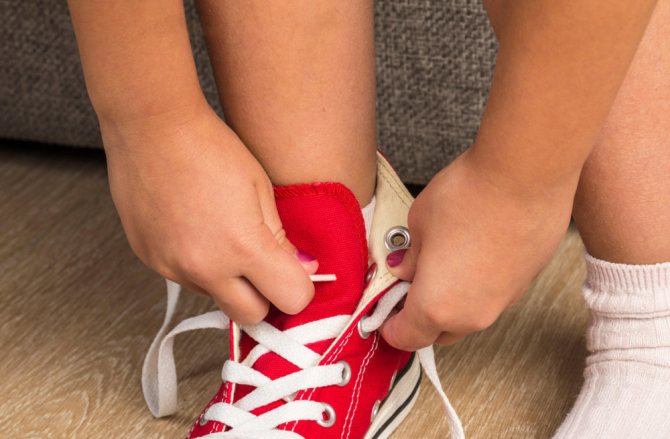
Training teaches discipline
Effective and interesting training
How to learn to tie children's shoelaces? The most important thing is not to rush the baby, give him the opportunity to try it himself, gently correcting his actions.
Success in mastering a new skill depends on the number of repetitions. Even if the baby coped with it and was able to tie a “bow”, then you need to remember to consolidate the result.
Note ! It is worth understanding the need for praise and approval for efforts. This is very motivating for further learning. A beginning baby will not want to continue learning if he encounters criticism or indifference from adults.
It is best to use a step-by-step teaching method, because it will be very difficult for a little child to remember and reproduce the entire list of actions at once. By breaking the whole process into parts, you can achieve a positive result much faster.
Poetry
There are a great many poems. For every child there is a children's poem that will help him master this new skill.
- "Mouse tail." A funny poem about little mice's tails tied in a bow.
- "Argument". An instructive poem about friendship. The ends of the lace appear to the baby as friends, who either make peace (when crossing) or quarrel (when moving away from each other).
- "Worms." A fascinating poem about funny worms who get confused and enjoy the new day.
Topic of the week: “My family” in the preparatory group
These and other poems, combined with interesting games and visual material, will help both boys and girls learn how to tie knots quickly and with pleasure.
List of exercise toys
The simplest thing a parent can do is buy his son or daughter some beautiful lace-up shoes. Explain to the child that he will be able to put them on himself when he learns to tie a knot himself, and his mother or father will help him with this. This way the baby will be motivated to master this skill faster.
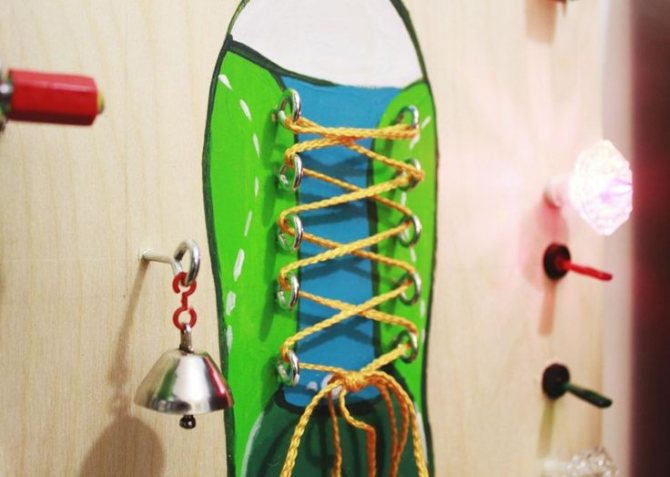
Busyboard helps a lot
Another common exercise toy is a bodyboard, which will have lacing on it that imitates shoes. Busy boards are made using bright materials that attract the baby’s attention, which will help him successfully and with interest master this new skill.
Examples of lacing games
The main activity of preschoolers is play, so it will be easier in a playful way to teach tying knots using the “bow” method. You can come up with games yourself, or you can use existing ones:
- "Catch the snake!" Tell your child that the lace is a small snake that needs to be caught. At the same time tell and show how to lace shoes.
- "Ears on top of the head." Ask the preschooler to imagine that the lacing bows are bunny ears, and show how they can be made shorter or longer. You can tell that short ears can stand upright for a long time.
- "Beautiful Butterfly" Lacing bows can also be imagined in the form of butterfly wings. Together with your child, it is useful to learn how to make wings larger or smaller.
- "Busyboard". This educational toy, containing an element that imitates lacing, will help you quickly teach your baby how to tie a bow in a playful way.
- "Friends-laces." Lacing can be compared to friends who always strive to be together and support each other.
The easiest way
The easiest and fastest way to master tying for a baby is the “two knot” method. It consists of placing each end of a cross on top of each other. Thread the end that is at the top from bottom to top and tie a regular knot. Repeat the manipulation. This creates two nodes on top of each other.
Note ! Of course, this method is not the most convenient, because if the baby ties the second knot too tightly, it will be difficult to untie, but for the beginning of learning it is easy and fits perfectly.











